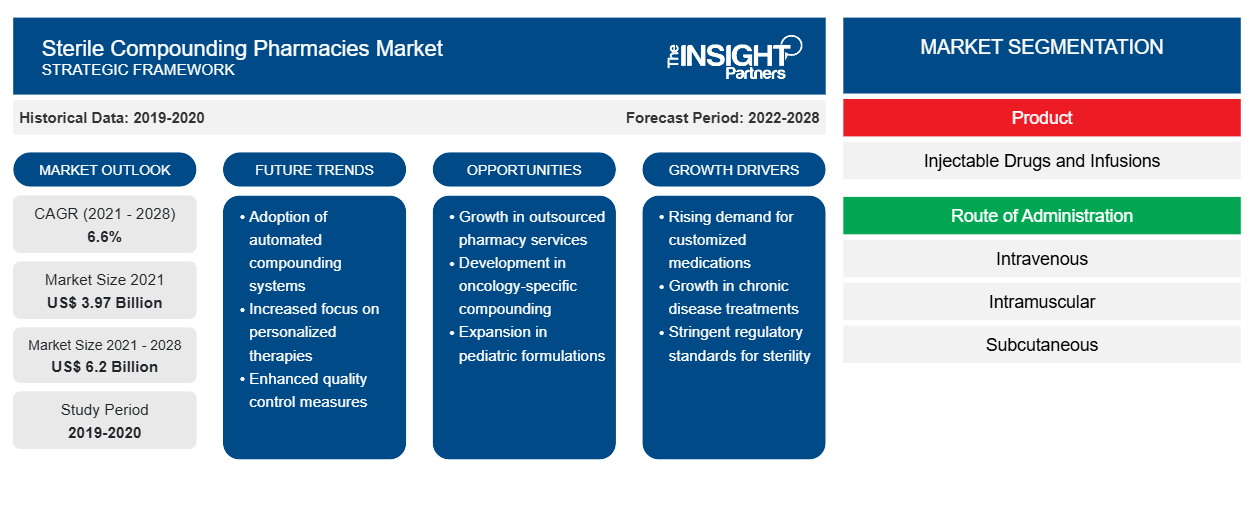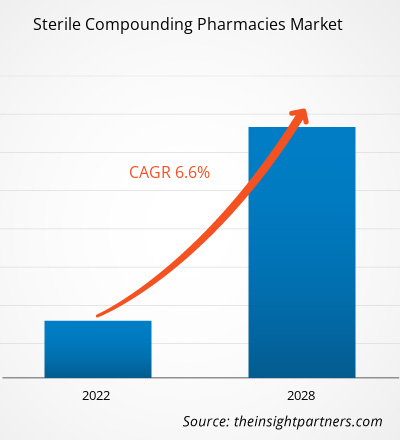[Research Report] The sterile compounding pharmacies market is projected to reach US$ 6,198.59 million by 2028 from US$ 3,968.70 million in 2021; it is expected to grow at a CAGR of 6.6% from 2021 to 2028.
Factors such as the rise in the uptake of personalized medicines and the benefits associated with on-site sterile compounding drive the growth of the market. However, product recalls and stringent regulatory requirements impede market growth. On the other hand, the development of centralized or regional compounding centers for customized formulations would create lucrative opportunities for market growth during the forecast period.
North America is likely to continue its dominance in the sterile compounding pharmacies market during 2021–2028. The US holds the largest share of the market in North America and is expected to continue this trend during the forecast period. This is primarily attributed to the rising pharmaceutical spending and the well-established healthcare infrastructure. For example, the Food and Drug Administration (FDA) has designated 503B (For records, 503B is referred to as an outsourcing facility and is sometimes referred to as 503B pharmacies and are strictly monitored by the FDA that establishes a new level of patient care and safety). Also, almost 75% of hospitals in the US outsource sterile compounding preparations to 503B facilities to ensure stability, cope up with drug shortages, obtain a ready-to-administer form of the drug, and extend shelf-life. Furthermore, the rising geriatric population and growing adoption of customized formulations over commercial products are expected to drive the growth of the US sterile compounding pharmacies market in the coming years.
Customize This Report To Suit Your Requirement
You will get customization on any report - free of charge - including parts of this report, or country-level analysis, Excel Data pack, as well as avail great offers and discounts for start-ups & universities
Sterile Compounding Pharmacies Market: Strategic Insights

-
Get Top Key Market Trends of this report.This FREE sample will include data analysis, ranging from market trends to estimates and forecasts.
Market Insights
Benefits of On-Site Sterile Compounding Drive Market Growth
On-site compounding and sterilization can prove vital in case of an intravenous solution intended to be customized as per the patient's need. On-site manufacturing allows the active pharmaceutical ingredient (API) to be introduced to human subjects during the starting phases of early clinical drug development. Sterile extemporaneous compounding offers a flexible option to the costly, extended development of parenteral investigational products designed by the Good Manufacturing (GMP) standards. Typically, parenterally administered API for clinical studies are manufactured under GMP conditions. This potentially reduces the time required for producing a finished product needed for specific dosing.
Moreover, compounding and filtering a formulation into a sterile intravenous solution successfully is met through strong collaboration with the pharmaceutical sponsor and clinical site pharmacists, where sterility testing can be conducted efficiently.
On-site sterile compounding has gained significant attention in the global market and is one of the most impacting factors responsible for market growth. This is due to sterile compounding pharmacists are focusing more on the latest research activities, innovative techniques, quality control rules, and getting the best ingredients to meet patients' needs. For example, the National Association of Boards of Pharmacy (NABP) announced receiving funding from the Food and Drug Administration (FDA) to develop a data-sharing system to improve oversight of sterile compounding pharmacies. This new system is expected to assist in collecting, managing, and sharing information related to sterile compounding in the US. The project also aims to reduce the risk of injury, favoring patients from drug products that have been improperly compounded.
Product-Based Insights
Based on product, the sterile compounding pharmacies market is bifurcated into injectable drugs and infusions. The injectable drugs segment would account for a larger market share during 2021–2028. Injectable drugs are among the highly preferred sterile compounding products due to their faster mode of action. To avoid any adverse effects on the patients, compounded injectable drugs (defined as drugs that are diluted, mixed, reconstituted, and prepared in an office) are compounded in such an environment where appropriate safeguards are maintained against the spread of disease and components of compounded drugs that are the appropriate strength and makeup. Market players are adopting organic and inorganic growth strategies for market growth. For instance, in September 2019, QuVa Pharma, Inc. declared a considerable increase in capacity for compounded sterile injectable preparations.
Sterile Compounding Pharmacies Market Regional InsightsThe regional trends and factors influencing the Sterile Compounding Pharmacies Market throughout the forecast period have been thoroughly explained by the analysts at The Insight Partners. This section also discusses Sterile Compounding Pharmacies Market segments and geography across North America, Europe, Asia Pacific, Middle East and Africa, and South and Central America.
Sterile Compounding Pharmacies Market Report Scope
| Report Attribute | Details |
|---|---|
| Market size in 2021 | US$ 3.97 Billion |
| Market Size by 2028 | US$ 6.2 Billion |
| Global CAGR (2021 - 2028) | 6.6% |
| Historical Data | 2019-2020 |
| Forecast period | 2022-2028 |
| Segments Covered |
By Product
|
| Regions and Countries Covered |
North America
|
| Market leaders and key company profiles |
|
Sterile Compounding Pharmacies Market Players Density: Understanding Its Impact on Business Dynamics
The Sterile Compounding Pharmacies Market is growing rapidly, driven by increasing end-user demand due to factors such as evolving consumer preferences, technological advancements, and greater awareness of the product's benefits. As demand rises, businesses are expanding their offerings, innovating to meet consumer needs, and capitalizing on emerging trends, which further fuels market growth.

- Get the Sterile Compounding Pharmacies Market top key players overview
Route of Administration-Based Insights
Based on route of administration, the sterile compounding pharmacies market is segmented into intravenous, intramuscular, and subcutaneous. The intravenous segment held the largest share of the market in 2020 and is projected to continue its dominance during the forecast period. However, the intramuscular segment is estimated to register the highest CAGR in the market during the forecast period. The intramuscular (IM) route of drug delivery is the most common route for parenteral injection. Many antibiotics, preoperative sedatives, and narcotics are given through the intramuscular route. For instance, in February 2021, Biogen, announced that the US Food and Drug Administration (FDA) approved a new intramuscular (IM) injection for "Plegridy (peginterferon beta-1a) responsible for treating multiple sclerosis (MS).
Companies operating in the sterile compounding pharmacies market adopt the product innovation strategy to meet the evolving customer demands across the world, which also permits them to maintain their brand name in the global market.
Based on product, the sterile compounding pharmacies market is bifurcated into injectables and infusions.
Based on route of administration, the sterile compounding pharmacies market is segmented into intravenous, intramuscular, and subcutaneous
Sterile Compounding Pharmacies Market Size – by Geography
- North America
- US
- Canada
- Mexico
- Europe
- France
- Germany
- Italy
- UK
- Spain
- Rest of Europe
- Asia Pacific (APAC)
- China
- India
- South Korea
- Japan
- Australia
- Rest of APAC
- Middle East and Africa (MEA)
- South Africa
- Saudi Arabia
- UAE
- Rest of MEA
- South and Central America (SCAM)
- Brazil
- Argentina
- Rest of SCAM
Company Profiles
- Fagron, Inc.
- Triangle Compounding Pharmacy
- B. Braun Melsungen AG
- PharMedium Healthcare Holdings, Inc.
- Fresenius Kabi AG
- Avella specialty Pharmacy
- Pencol Compounding Pharmacy
- Pavilion Compounding Pharmacy LLC
- Pace Pharmacy
- SandsRx
Frequently Asked Questions
What are the driving factors for the sterile compounding pharmacies market across the globe?
Which segment led the sterile compounding pharmacies market?
Which route of administration segment held the largest revenue (US$ Mn) in the sterile compounding pharmacies market?
What is meant by the sterile compounding pharmacies market?
What is the regional market scenario of the sterile compounding pharmacies market?
Who are the key players in the sterile compounding pharmacies market?
- Historical Analysis (2 Years), Base Year, Forecast (7 Years) with CAGR
- PEST and SWOT Analysis
- Market Size Value / Volume - Global, Regional, Country
- Industry and Competitive Landscape
- Excel Dataset
Recent Reports
Related Reports
Testimonials
Reason to Buy
- Informed Decision-Making
- Understanding Market Dynamics
- Competitive Analysis
- Identifying Emerging Markets
- Customer Insights
- Market Forecasts
- Risk Mitigation
- Boosting Operational Efficiency
- Strategic Planning
- Investment Justification
- Tracking Industry Innovations
- Aligning with Regulatory Trends





















 Get Free Sample For
Get Free Sample For